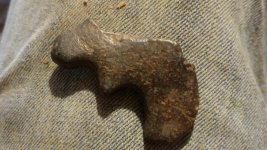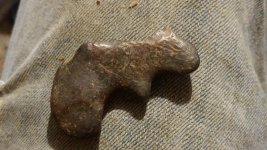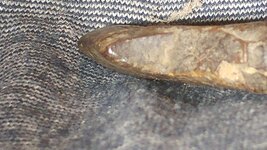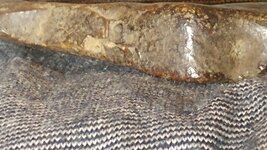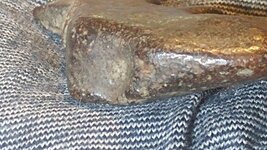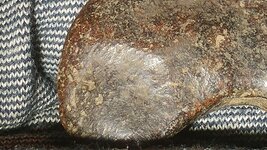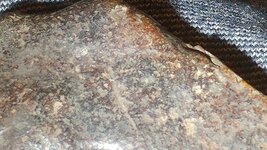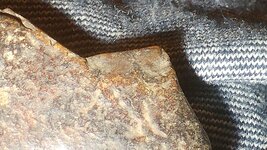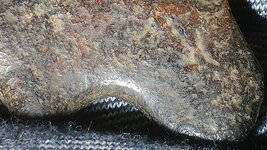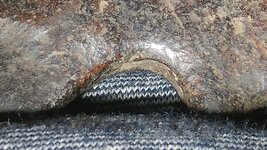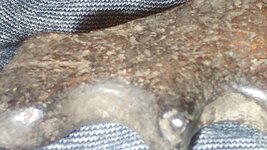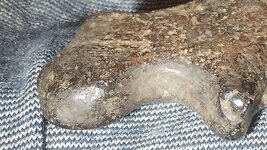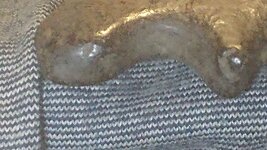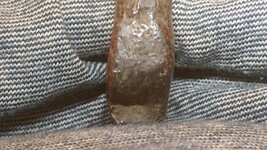Navigation
Install the app
How to install the app on iOS
Follow along with the video below to see how to install our site as a web app on your home screen.
Note: This feature may not be available in some browsers.
More options
You are using an out of date browser. It may not display this or other websites correctly.
You should upgrade or use an alternative browser.
You should upgrade or use an alternative browser.
Squirrel or beaver effigy?
- Thread starter Freemindedclark
- Start date
- Jun 8, 2006
- 6,281
- 8,900
- Detector(s) used
- Whites, Minelab, Tesoro, and custom machines
- Primary Interest:
- Metal Detecting
Could be natural?
The Grim Reaper
Gold Member
Could be natural?
Could be?? There's no doubt in my mind it's natural.
jonesy
Jr. Member
not a flake or mark on it.....natural
Wampum
Full Member
The lack of flakes or marks does not mean this is not man made. Catlinite effigies are perfect examples. Many native stone tools and adornments are ground. As for this I don't know without seeing more angles or knowing if it comes from a confirmed NA site. If it was just found at random with no nearby native stuff I would say probably not. If it was found near NA stuff I would say a solid maybe. If it was catlinite I would say probably.
The Grim Reaper
Gold Member
Sorry, shouldn't have posted that.
Last edited:
arrow86
Silver Member
Maybe it's native American brass knuckles or I guess stone knuckles
I have doubts (a lot) but the round humps have me interested in seeing more pictures. Would like more context of where found. Every time I see title effigy always skeptical but shape is odd. I def would have picked this up if at a site to ask for second looks. Like to see if any marks around edges of the humps
Last edited:
Freemindedclark
Sr. Member
- Thread starter
- #11
It was found on the 7 mile creek in an area hopping with artifacts. I will get more pics. Natural. Lol.
Charl
Silver Member
I would have liked to see the interior surfaces of the indentations as well. How can I know if those indentations have not been pecked and ground in if I can't even see them?? Sure it's likely natural, but I've been collecting for 60 years and I have found many rudimentary waterworn notched weights because I picked up a "possibility" and was able to detect pecking in or around the notches even though waterworn. Of course this is not a notched weight nor a squirrel effigy. But I would have picked it up to more closely examine the notches, which, again, do not show their interior surfaces in these photos. And I don't think I would need to take up stamp collecting just because I wanted to satisfy my curiosity....
unclemac
Gold Member
- Oct 12, 2011
- 7,258
- 7,385
- Primary Interest:
- Beach & Shallow Water Hunting
look at it this way...if someone took the great amount of time to fashion that stone, with all the pecking, grinding and smoothing....they would have taken the short amount of extra time to make it obvious as an effigy.
Freemindedclark
Sr. Member
- Thread starter
- #16
Freemindedclark
Sr. Member
- Thread starter
- #17
I'm no expert but that appears to have been pecked to me.
Top Member Reactions
-
 3359
3359 -
 1898
1898 -
 1854
1854 -
 1149
1149 -
 1095
1095 -
 867
867 -
 852
852 -
 841
841 -
 832
832 -
 751
751 -
 742
742 -
 549
549 -
 536
536 -
 498
498 -
 443
443 -
 428
428 -
E
415
-
 402
402 -
 393
393 -
 392
392
Users who are viewing this thread
Total: 2 (members: 0, guests: 2)
